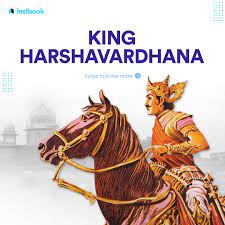Harshavardhan
King of Vardhana Dynasty
Fall of Gupta Empire and rise of Harshavardhan
Harsha was the second son of Prabhakarvardhana, king of Thanesar. after the fall of the prior Gupta Empire, Harsha united the small republics from Punjab to central India, and their representatives crowned him king at an assembly in April 606 giving him the title of Maharaja. Harsha established an empire that brought all of northern India under his control.
Pulkeshin II
Pulakeshin then entered into a treaty with Harsha, with the Narmada River designated as the border between the Chalukya Empire and that of Harshavardhana. Earlier , the rapid expansion of Harshavardhan led to tensions between him and the Chalukya king Pulakeshin II (r. 609-642 CE). It was now that the most powerful kingdoms of northern and southern India came face-to-face on the battlefield on the banks of river Narmada. In the end, the southerners under the able leadership of Pulakeshin II prevailed leaving the ambitious northern ruler, Harsha, defeated. Harsha lost his cheer when he saw his elephants dying in the battle. Harsha entered a peace treaty with the Chalukya king, which established Narmada river as the southern boundary of his empire and after that he never advanced south again. Yet, this did not halt his conquest of the north. He took the title of sakal uttara patha natha (lord of northern India)
Empire
During Harshvardhan's rule Vardhan dynasty's geographical boundaries was spread from North to South, Nepal to Narmada river and East to West from Assam to Gujarat. He had a friendly relations with King of Kamrup, Bhaskarvarman and sent his envoy in the court of Chinese King, formed friendly relations. Harshvardhan established state's capital at , Kannauj. He use to spend major part of state's income to welfare of his subjects. He use to donate his wealth after every 5 years
Religion
Since Harsha's own records describe him as Shaivite, his conversion to Buddhism would have happened, if at all, in the later part of his life. Even Xuanzang states that Harsha patronised scholars of all religions, not just Buddhist monks. According to historians such as S. R. Goyal and S. V. Sohoni, Harsha was personally a Shaivite and his patronage to Buddhists misled Xuanzang to portray him as a Buddhist
Legacy
he Vardhana Empire consisted of two distinctive types of territories: areas directly under Harsha's rule such as Central Provinces, Gujarat, Bengal, Kalinga, Rajputana, and the states and kingdoms which had become feudatories under him including Jalandhar, Kashmir, Nepal, Sind, Kamarupa (modern-day Assam). Thus, many historians do not find the title justified as he was never able to bring the entire north under a single command. Yet, this does not mean his power was not felt beyond the limits of his direct rule. His writ ran across entire north India. Under his command, King of Jalandhar escorted the Chinese traveller Hiuen Tsang to the frontiers of India. Another time, king of Kashmir had to submit a tooth relic of Buddha to Harsha. The Chinese source suggests that the King of Kamarupa could not dare to detain a Chinese pilgrim in his capital against the wishes of Harsha.
The Alchon Huns invasion of the Indian subcontinent eradicated the Kidarite Huns who had preceded them by about a century, and contributed to the fall of the Gupta Empire, in a sense bringing an end to Classical India. There was a period of tension as India had to frequently deal with the invasion of the Huns of Central Asia. Constant fights were so costly that they weakened the empire to the core, and this eventually led to the downfall of the Gupta Empire. As the western frontiers of India and areas adjoining the Indus river were under the occupation of Huns, skirmishes between Huns and Thaneshwar were regular.
Harshavardhan defeated Huns and united North Indian states which were earlier under Gupta Empire.
Harsha died in 647 AD, and the empire with him. The death of Harshavardhana is not well documented.

Harsha
sakal uttara patha natha (lord of northern India)
Jai Hind